Dinner usually refers to what is in many Western cultures the largest and most formal meal of the day. Historically, the largest meal used to be eaten around midday, and called dinner. Especially among the elite, it gradually migrated to later in the day over the 16th to 19th centuries. The word has different meanings depending on culture, and may mean a meal of any size eaten at any time of day. In particular, it is still sometimes used for a meal at noon or in the early afternoon on special occasions, such as a Christmas dinner. In hot climates, the main meal is more likely to be eaten in the evening, after the temperature has fallen.
The following outline is provided as an overview of and topical guide to meals:
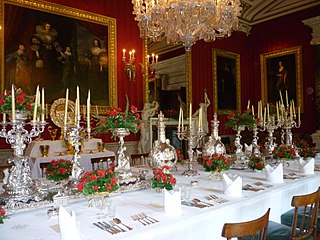
Tableware is any dish or dishware used for setting a table, serving food, and dining. It includes cutlery, glassware, serving dishes, and other items for practical as well as decorative purposes. The quality, nature, variety and number of objects varies according to culture, religion, number of diners, cuisine and occasion. For example, Middle Eastern, Indian or Polynesian food culture and cuisine sometimes limits tableware to serving dishes, using bread or leaves as individual plates, and not infrequently without use of cutlery. Special occasions are usually reflected in higher quality tableware.
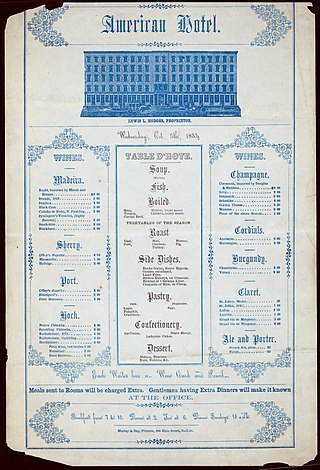
In restaurant terminology, a table d'hôte menu is a menu where multi-course meals with only a few choices are charged at a fixed total price. Such a menu may be called prix fixe. The terms set meal and set menu are also used. The cutlery on the table may also already be set for all of the courses.
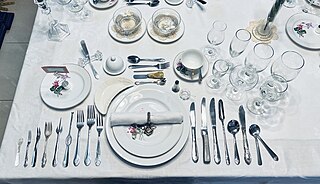
A full-course dinner is a dinner consisting of multiple dishes, or courses. In its simplest form, it can consist of three or four courses; for example: first course, a main course, and dessert.
A side dish, sometimes referred to as a side order, side item, or simply a side, is a food item that accompanies the entrée or main course at a meal.

Charger plates or service plates are large plates used at full course dinners or to dress up special events like parties and weddings. Charger plates have been in use since the 19th century.
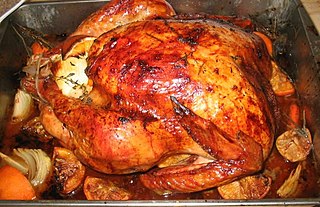
Christmas dinner is a meal traditionally eaten at Christmas. This meal can take place any time from the evening of Christmas Eve to the evening of Christmas Day itself. The meals are often particularly rich and substantial, in the tradition of the Christian feast day celebration, and form a significant part of gatherings held to celebrate the arrival of Christmastide. In many cases, there is a ritual element to the meal related to the religious celebration, such as the saying of grace.
The historical form of service à la russe is a manner of dining with courses brought to the table sequentially, and the food portioned on individual plates by the waiter. It contrasts with the older service à la française based on several courses brought to the table simultaneously, in an impressive display of tureens and serving dishes, with diners plating food themselves.

A state banquet is an official banquet hosted by the head of state in his or her official residence for another head of state, or sometimes head of government, and other guests. Usually as part of a state visit or diplomatic conference, it is held to celebrate diplomatic ties between the host and guest countries. Depending on time of the day, it may be referred to as a state dinner or state lunch. The size varies, but the numbers of diners may run into the hundreds.
The Feast of the Seven Fishes is an Italian-American celebration of Christmas Eve with dishes of fish and other seafood.
Restaurants fall into several industry classifications, based upon menu style, preparation methods and pricing, as well as the means by which the food is served to the customer. This article mainly describes the situation in the USA, while categorisation differs widely around the world.
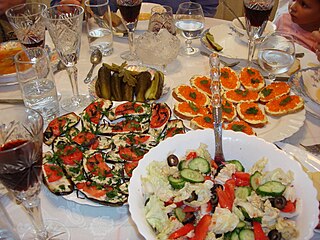
Zakuski is an assortment of cold hors d'oeuvres, entrées and snacks in food culture of Russia and in Slavic-speaking countries. It is served as a course on its own or "intended to follow each shot of vodka or another alcoholic drink." The word literally means 'something to bite after'. It probably originated and was influenced through the fusion of Slavic, Viking-Nordic and Oriental cultures in early Rus' regions like the Novgorod Republic.

Eleven Madison Park is a New American fine dining restaurant located inside the Metropolitan Life North Building at 11 Madison Avenue in the Flatiron District of Manhattan, New York City. It has retained 3 Michelin stars since 2012, and was ranked third among The World's 50 Best Restaurants in 2016, and topped the list in 2017.

Pollen Street Social is a restaurant in London, England, run by chef Jason Atherton. It was Atherton's first UK solo restaurant, and in 2011 was named the best new UK restaurant by the Good Food Guide, and the best new fine-dining restaurant in London by Time Out. It currently holds one Michelin star, which it gained within a year of opening. Elements in the restaurant such as the dessert bar have been subsequently included in Atherton's other restaurants.

The Eucalyptus is a Jerusalem fine dining restaurant. It is noted for its use of biblical ingredients and the use of wild plants and roots foraged from the nearby hillsides, and for preparing traditional and innovative Levantine, Arab, and Jewish cuisine.
Glen Deven Ranch is an 860 acres (350 ha) property in Big Sur that was given to the Big Sur Land Trust in 2001 by Seeley and Virginia Mudd. Composed of coastal woodlands, coastal river lands, grasslands and wildlife, it is used by the Trust each summer as an outdoor summer camp to teach inner-city youth about coastal ecosystems. The ranch is accessible via Highway 1 east on Palo Colorado Road, to Garrapatos Road. The ranch's roads also offer residents of Palo Colorado Canyon an emergency exit during a flood or fire.
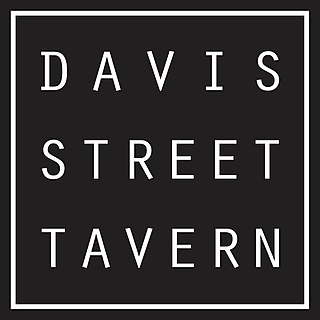
Davis Street Tavern was a restaurant in Portland, Oregon's Old Town Chinatown neighborhood. Christopher Handford, chef Gabriel Kapustka, and Handford's cousin Blake Smith opened the restaurant serving American cuisine in 2008. The building that housed it was previously a bakery. Kapustka left in 2010, after being bought out by partners. Subsequent executive chefs were Scott Shampine and Katy Jane Millard. The restaurant hosted an annual supper celebrating Robert Burns. In 2012, Davis Street Tavern and the Oregon Restaurant and Lodging Association led an effort by industry groups to overturn the U.S. Department of Labor's rules prohibiting gratuity sharing with kitchen staff. The restaurant closed in September 2016.

Fisherman's Restaurant and Bar is a seafood restaurant in Seattle, in the U.S. state of Washington.














